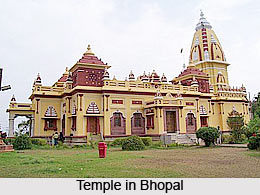 Tourism in Bhopal, Madhya Pradesh includes some of the most important sites which narrate the history around Bhopal. Bhopal, the ancient and medieval capital of Central India is popularly known for the minarets, mosques and temples that overshadow the congested dwelling units and roads of the city. While the interior of Bhopal city is decorated with palaces and attractive lakes, sights around Bhopal are equally attractive. Some of the prominent tourist sites around Bhopal include Bhojpur, Chiklod, Raisen, Bhimbetka, Ginnorgarh Fort and Sanchi which are not only major tourist spots but also historical sites that surround the city of Bhopal. Some of the most popular tourist spots of Bhopal have been discussed below:
Tourism in Bhopal, Madhya Pradesh includes some of the most important sites which narrate the history around Bhopal. Bhopal, the ancient and medieval capital of Central India is popularly known for the minarets, mosques and temples that overshadow the congested dwelling units and roads of the city. While the interior of Bhopal city is decorated with palaces and attractive lakes, sights around Bhopal are equally attractive. Some of the prominent tourist sites around Bhopal include Bhojpur, Chiklod, Raisen, Bhimbetka, Ginnorgarh Fort and Sanchi which are not only major tourist spots but also historical sites that surround the city of Bhopal. Some of the most popular tourist spots of Bhopal have been discussed below:
Ginnogarh Fort
Ginnogarh Fort is an important tourist spot near Bhopal. Built on a flat hill top this palace is mainly known for its architecture and large variety of parrots which fly at every corner of the palace making it more attractive for the tourists.
 Bhojpur
Bhojpur
Bhojpur is one of the major sights around Bhopal which is located at a distance of 28 km from Bhopal. This is popularly known for the famous Shiva temple built by Raja Bhoj in the 11th century. Also known as Somnath Temple in Northern India, this place is famous for the age old Shiva lingam which is carved out of one single stone.
Chiklod
Chiklod is another important sight around Bhopal which is known for the famous lake palace that is located 45 kms from the city of Bhopal. This place used to entertain the Nawabs with a number of gorgeous and picturesque lakes and gardens that make the place best for tourism.
 Raisen
Raisen
Raisen, a historical sight known for the fortresses, is situated 47 km away from Bhopal. This place is important for its strategic location in the Malwa region. This place has three palaces, nine gateways, four tanks and forty wells and some valuable inscriptions which mark the place as one of the most important historical sites around Bhopal.
Bhimbetka Caves
Bhimbetka is located 40 kilometers away from Bhopal. Situated on the northern fringes of Vindhyachal Mountains this is a small village which attracts tourists towards the archaeological site that has been discovered in the area. Surrounded with 600 caves and rock shelters this includes the reminiscences of Neolithic age which marks it as one of the oldest sights in India.
 Other Tourist spots in Bhopal
Other Tourist spots in Bhopal
Other tourist spots in Bhopal include some picnic spots like Ajnal which is 16 km from Raisan, Hathaikhem 10 kms away from Bhopal, Neori and Samardha which is surrounded by grassland and forests. Another most popular tourist sight around Bhopal is Sanchi which is famous for its Buddhist Stupas and monasteries. Located at a height of 91 kilometers this place has some of the largest and well maintained Buddhist monasteries and Stupas in India.



















